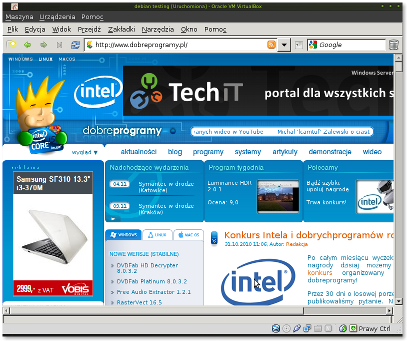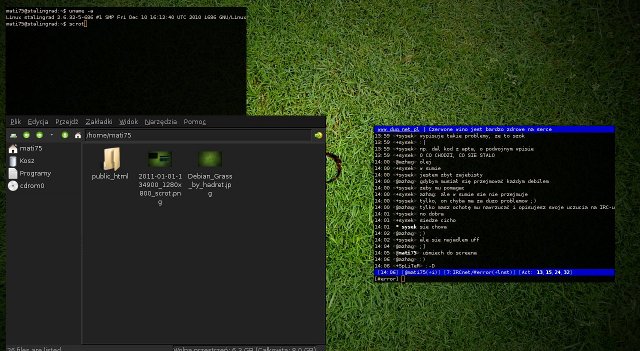Witajcie! Już dawno miałem opisać ten menadżer okien dla systemów Linux i BSD. Według danych na dzień dzisiejszy jest on najlżejszym dostępnym. Przedstawie dwa zastowania dla niego.
Podzieliłem tekst na 3 części:
- Cześć 1- TinyWM jako kiosk internetowy [1]
- Cześć 2 - TinyWM jako panel administratora [2]
- Podsumowanie [3]
Część 1 
[15] [9] [4]
Kod źródłowy
Oczywiście nie będę wszystkiego opisywał, bo nie oto chodzi. Cały kod źródłowy to 50 linijek w języku C. Mniej już się nie da. Wersja 1.3 wygląda tak:
/* TinyWM is written by Nick Welch , 2005.
*
* This software is in the public domain
* and is provided AS IS, with NO WARRANTY. */
/* much of tinywm's purpose is to serve as a very basic example of how to do X
* stuff and/or understand window managers, so i wanted to put comments in the
* code explaining things, but i really hate wading through code that is
* over-commented -- and for that matter, tinywm is supposed to be as concise
* as possible, so having lots of comments just wasn't really fitting for it.
* i want tinywm.c to be something you can just look at and go "wow, that's
* it? cool!" so what i did was just copy it over to annotated.c and comment
* the hell out of it. ahh, but now i have to make every code change twice!
* oh well. i could always use some sort of script to process the comments out
* of this and write it to tinywm.c ... nah.
*/
/* most X stuff will be included with Xlib.h, but a few things require other
* headers, like Xmd.h, keysym.h, etc.
*/
#include
#define MAX(a, b) ((a) > (b) ? (a) : (b))
int main()
{
Display * dpy;
Window root;
XWindowAttributes attr;
/* we use this to save the pointer's state at the beginning of the
* move/resize.
*/
XButtonEvent start;
XEvent ev;
/* return failure status if we can't connect */
if(!(dpy = XOpenDisplay(0x0))) return 1;
/* you'll usually be referencing the root window a lot. this is a somewhat
* naive approach that will only work on the default screen. most people
* only have one screen, but not everyone. if you run multi-head without
* xinerama then you quite possibly have multiple screens. (i'm not sure
* about vendor-specific implementations, like nvidia's)
*
* many, probably most window managers only handle one screen, so in
* reality this isn't really *that* naive.
*
* if you wanted to get the root window of a specific screen you'd use
* RootWindow(), but the user can also control which screen is our default:
* if they set $DISPLAY to ":0.foo", then our default screen number is
* whatever they specify "foo" as.
*/
root = DefaultRootWindow(dpy);
/* you could also include keysym.h and use the XK_F1 constant instead of
* the call to XStringToKeysym, but this method is more "dynamic." imagine
* you have config files which specify key bindings. instead of parsing
* the key names and having a huge table or whatever to map strings to XK_*
* constants, you can just take the user-specified string and hand it off
* to XStringToKeysym. XStringToKeysym will give you back the appropriate
* keysym or tell you if it's an invalid key name.
*
* a keysym is basically a platform-independent numeric representation of a
* key, like "F1", "a", "b", "L", "5", "Shift", etc. a keycode is a
* numeric representation of a key on the keyboard sent by the keyboard
* driver (or something along those lines -- i'm no hardware/driver expert)
* to X. so we never want to hard-code keycodes, because they can and will
* differ between systems.
*/
XGrabKey(dpy, XKeysymToKeycode(dpy, XStringToKeysym("F1")), Mod1Mask, root,
True, GrabModeAsync, GrabModeAsync);
/* XGrabKey and XGrabButton are basically ways of saying "when this
* combination of modifiers and key/button is pressed, send me the events."
* so we can safely assume that we'll receive Alt+F1 events, Alt+Button1
* events, and Alt+Button3 events, but no others. You can either do
* individual grabs like these for key/mouse combinations, or you can use
* XSelectInput with KeyPressMask/ButtonPressMask/etc to catch all events
* of those types and filter them as you receive them.
*/
XGrabButton(dpy, 1, Mod1Mask, root, True, ButtonPressMask, GrabModeAsync,
GrabModeAsync, None, None);
XGrabButton(dpy, 3, Mod1Mask, root, True, ButtonPressMask, GrabModeAsync,
GrabModeAsync, None, None);
for(;;)
{
/* this is the most basic way of looping through X events; you can be
* more flexible by using XPending(), or ConnectionNumber() along with
* select() (or poll() or whatever floats your boat).
*/
XNextEvent(dpy, &ev);
/* this is our keybinding for raising windows. as i saw someone
* mention on the ratpoison wiki, it is pretty stupid; however, i
* wanted to fit some sort of keyboard binding in here somewhere, and
* this was the best fit for it.
*
* i was a little confused about .window vs. .subwindow for a while,
* but a little RTFMing took care of that. our passive grabs above
* grabbed on the root window, so since we're only interested in events
* for its child windows, we look at .subwindow. when subwindow
* None, that means that the window the event happened in was the same
* window that was grabbed on -- in this case, the root window.
*/
if(ev.type == KeyPress && ev.xkey.subwindow != None)
XRaiseWindow(dpy, ev.xkey.subwindow);
else if(ev.type == ButtonPress && ev.xbutton.subwindow != None)
{
/* now we take command of the pointer, looking for motion and
* button release events.
*/
XGrabPointer(dpy, ev.xbutton.subwindow, True,
PointerMotionMask|ButtonReleaseMask, GrabModeAsync,
GrabModeAsync, None, None, CurrentTime);
/* we "remember" the position of the pointer at the beginning of
* our move/resize, and the size/position of the window. that way,
* when the pointer moves, we can compare it to our initial data
* and move/resize accordingly.
*/
XGetWindowAttributes(dpy, ev.xbutton.subwindow, &attr);
start = ev.xbutton;
}
/* the only way we'd receive a motion notify event is if we already did
* a pointer grab and we're in move/resize mode, so we assume that. */
else if(ev.type == MotionNotify)
{
int xdiff, ydiff;
/* here we "compress" motion notify events. if there are 10 of
* them waiting, it makes no sense to look at any of them but the
* most recent. in some cases -- if the window is really big or
* things are just acting slowly in general -- failing to do this
* can result in a lot of "drag lag."
*
* for window managers with things like desktop switching, it can
* also be useful to compress EnterNotify events, so that you don't
* get "focus flicker" as windows shuffle around underneath the
* pointer.
*/
while(XCheckTypedEvent(dpy, MotionNotify, &ev));
/* now we use the stuff we saved at the beginning of the
* move/resize and compare it to the pointer's current position to
* determine what the window's new size or position should be.
*
* if the initial button press was button 1, then we're moving.
* otherwise it was 3 and we're resizing.
*
* we also make sure not to go negative with the window's
* dimensions, resulting in "wrapping" which will make our window
* something ridiculous like 65000 pixels wide (often accompanied
* by lots of swapping and slowdown).
*
* even worse is if we get "lucky" and hit a width or height of
* exactly zero, triggering an X error. so we specify a minimum
* width/height of 1 pixel.
*/
xdiff = ev.xbutton.x_root - start.x_root;
ydiff = ev.xbutton.y_root - start.y_root;
XMoveResizeWindow(dpy, ev.xmotion.window,
attr.x + (start.button==1 ? xdiff : 0),
attr.y + (start.button==1 ? ydiff : 0),
MAX(1, attr.width + (start.button==3 ? xdiff : 0)),
MAX(1, attr.height + (start.button==3 ? ydiff : 0)));
}
/* like motion notifies, the only way we'll receive a button release is
* during a move/resize, due to our pointer grab. this ends the
* move/resize.
*/
else if(ev.type == ButtonRelease)
XUngrabPointer(dpy, CurrentTime);
}
}
Większość w powyższym kodzie to opisy w języku angielskim do poszczególnych sekcji, dlatego wydaje się on dłuższy.
Praktyczne zastosowanie - kiosk internetowy
Normalnych praktycznych zastosowań dla tego menadżera właściwie nie ma. (pewnie się zastanawiasz po co w ogóle ja to pisze) Jednym, które ma jakiś sens jest zastosowanie w kiosku internetowym, profesjonalnie zwanym kiosk mode. Jest to sama przeglądarka internetowa udostępniona użytkownikom końcowym.
Jako system bazowy posłużę się Debianem w wersji 6.0 beta 1. Obraz instalacyjny systemu w wersji 32 bitowej dostępny tutaj. Jako przeglądarkę internetową wykorzystam midori w wersji 0.2.9 pochodzącą z repozytorium Hadreta [5].
Oczywiście większość dystrybucji zawiera opisywany menadżer w swoich repozytoriach, wybrałem Debiana bo jego obraz instalacyjny miałem pod ręką.
Instalujemy system klikając dalej, dalej itd. Wybieramy tylko system podstawowy, czyli na tym ekranie nie wybieramy nic.
 [6]
[6]
Po zainstalowaniu systemu logujemy się na użytkownika root i instalujemy następujące paczki: apt-get install xorg tinywm midori
Jeśli ktoś chce nowsze midori musi dodać następujące repozytorium:
nano /etc/apt/sources.list
i dodać to:
deb http://hadret.rootnode.net/debian/ unstable main
(zapisuje się ctrl +x ) oraz wykonać polecenie wyżej. Po zainstalowaniu wylogowujemy się z roota i logujemy na użytkownika końcowego i wykonać polecenie:
nano ~/.xinitrc
i wkleić: * jeśli tylko zobaczyć jak działa sam menadżer:
xsetroot -solid black &
xterm &
tinywm
od razu z przeglądarką
xsetroot -solid black & xterm & midori & tinywm
W pierwszym przypadku wygląda to tak:
zaś w drugim:
Zmieniamy rozmiar przeglądarki i działa.
Część 2 
[15] [9] [4]
TinyWM jako panel administratora
O ile system Windows Server ciężko się zarządza przez tryb tekstowy, to w systemach uniksowych jest prostsze. Pomimo tego wiele osób, które zaczynają swoją przygodę z administrowaniem serwerów pracujących pod kontrolą systemów Linux/BSD ma problem. Chciałyby najlepiej wszystko "wyklikać". W związku z tym, że im mniej zainstalowanych rzeczy w systemie serwerowym, tym bezpieczniej i wydajniej. Tutaj przedstawiane środowisko idealnie pasuje. Do prezentacji możliwości posłużę, że się systemem Debian Squezee (6.0) w wersji 32 bitowej działający na platformie XEN [10] działającej na serwerze Dell R710.
Przygotowanie środowiska do pracy
Podobnie jak w przypadku web kiosku potrzebujemy X Window System i menadżer okien oraz serwera pulpitu zdalnego (vnc). Ten ostatni tylko w wypadku zdalnej konfiguracji.
apt-get install xorg xserver-xorg tinywm x11vnc
Konfiguracja pakietu x11vnc jest dostępna tutaj. Na przeszkodzie nie stoi również wykorzystanie jako serwera pulpitu zdalnego aplikacji NoMachine NX [11].
Również wykorzystuję następujące pakiety:
apt-get install feh htop irssi pcmanfm rxvt-unicode gmrun
- feh - jako menadżer tapety, by ładnie wyglądało
- htop - rozwinięta wersja programu top, menadżer zadań/uruchomionych procesów
- irrsi - klient sieci irc (zrzut 2)
- pcmanfm - lekki menadżer plików
- rxvt-unicode - w skrócie zwany urxvt - terminal
- gmrun - starter programów
Panel informujący administratora
Konfiguracja pliku .xinitrc:
feh --bg-scale ~/Debian_Grass_by_hadret.jpg &
urxvt -g 80x24+0+0 &
urxvt -g 80x24+0+0 &
gmrun &
tinywm
Ta konfiguracja uruchamia 2 terminale, które można przesunąć kombinacją klawiszy "lewy alt + lewy klawisz myszy" oraz starter programów.
Tak to wygląda w działaniu:
W terminalu została uruchomiona aplikacja htop.
Panel zarządzania plikami
Zauważyłem mało osób lubi korzystać z konsolowej aplikacji do zarządzania plikami mc. Wolą jednak klikać. Więc można również w takim przypadku wykorzystać menadżer TinyWM.
Konfiguracja pliku .xinitrc:
feh --bg-scale ~/Debian_Grass_by_hadret.jpg &
urxvt -g 80x24+0+0 &
pcmanfm &
gmrun &
tinywm
W tym przypadku wykorzystałem również aplikację lxappearance:
apt-get install lxappearance
aby dostosować wygląd menadżera, bo po standardowej instalacji za ładnie nie wygląda. Wykorzystałem do tego styl: Drakfire Black [13] oraz ikony nuoveXT.2.2.
Wygląda to tak:
W terminalu została uruchomiona aplikacja irssi, służąca do komunikacji za pomocą sieci irc. W tym przypadku czysto dla rozrywki.
Podsumowanie 
[15] [9] [4]
Myślę, że w zupełności zaprezentowałem możliwości tego malutkiego środowiska. Jeśli ma ktoś jakiś pomysł pisać, spróbuje zaprezentować. W niniejszej prezentacji wykorzystałem tapetę Debian Grass autorstwa Hadreta [16].
Pozdrawiam serdecznie!



